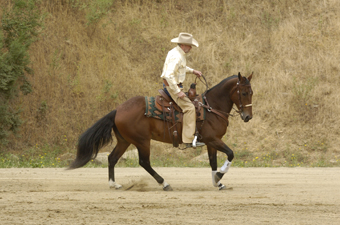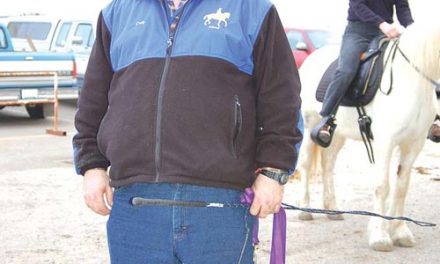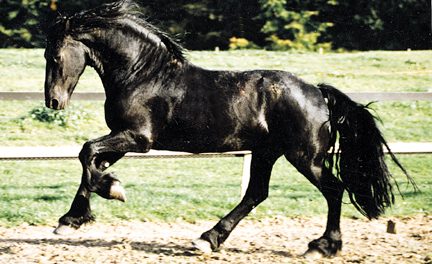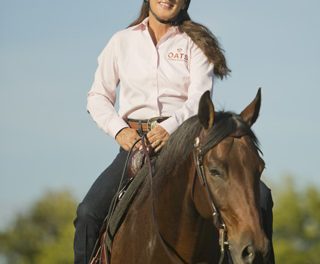
Counter-cantering to the right with collection.
“What’s going on? I thought that person was a good rider. Don’t they know that they are on the wrong lead?” That’s typically what the novice rider thinks or says while observing a trainer counter-cantering a horse.
Let’s take a moment to demystify this training maneuver. A counter-canter is the purposeful act of cantering or loping the horse in one direction while maintaining the opposite lead. For example, if you are cantering on a circle to the left, your horse would be on the right lead, not on the usual left lead. Likewise, if you are cantering to the right, your horse would be on the left lead.
The counter-canter is not something that an instructor would attempt to teach a beginning rider. The beginner needs to concentrate on picking up and maintaining the correct lead. However, as a horse and rider advance, the counter-canter can be a very beneficial maneuver.
The reason we counter-canter is to establish and refine body control. In able to reach higher levels of performance, a rider must have absolute body control of the horse. We need to be able to put any part of our horse’s body into any position at any time. When a counter-canter is done correctly, a horse’s body parts are aligned in a very specific and disciplined way.
Many performance-oriented problems stem from lazy shoulders or poor shoulder control. Horses tend to “drop” a shoulder in the direction they are going, which often causes them to fall out of lead or miss a flying lead change. Counter-cantering can help a horse’s shoulders stay straight and elevated regardless of the direction or lead.
Counter-canter exercise. Here is a great exercise to help your horse counter-canter and develop more body control. Lope in a square pattern, rather than in a circle while performing the counter-canter. Start by loping to the left, meaning you’ll be on the right lead. Lope straight ahead along one side of the square, with collection and supple contact with your reins.
When it is time to turn a 90 degree angle to the left, tip your horse’s nose slightly to the right. Use your left leg, back and in, to push the hind quarters of your horse around the corner. Now, straighten out and lope to the next 90 degree left hand turn and repeat. It will feel like you are doing a lot with your horse’s hips. And that’s true. However, the greater benefit is in keeping your horse’s shoulders straight and upright throughout the maneuver.
If you decide to change leads, you will tip your horse’s nose slightly in the opposite direction, away from the lead you are on. Then you will use your outside right leg to move your horse’s hip into the new lead.
Counter-canter on a figure-eight exercise. Doing the counter-canter can be very beneficial for the horse that anticipates the lead change in the middle of a figure-eight. The main purpose of this exercise is to make sure your horse waits for your direction and does not anticipate the maneuvers.
Lope a figure-eight pattern. When you pass through the center of the figure-eight, instead of changing leads as you normally would, continue loping on the same lead — meaning your horse is now doing the counter-canter. Don’t let your horse change leads on his own; the lead change needs to be your idea. You might not decide not to change leads at all and simply continue around the circle at the counter-canter. Once you cross the middle of the figure-eight again, your horse will be back on the correct lead.
Are you struggling with keeping your horse soft in the face at speed? Is he not readily moving off your leg? You might need to go back and get these things better before you’ll be able to enjoy the full benefits of counter-cantering. After spending so much time helping your horse pick up the correct lead, he’ll often find it awkward and fatiguing to correctly counter-canter. Yet, with practice you and your horse should become more proficient.
Richard Winters is a performance horse trainer with a natural horsemanship touch. For over 20 years, he has helped people with their horses through his training programs, clinics, DVDs, and his presentations at horse expos. His horsemanship is universal, ranging from reined cow horses on the Western side to jumping and dressage on the English side. Learn more about Richard at www.wintersranch.com.
Richard just won the 2009 Road to the Horse Colt Starting Competition, which was held March 14-15, 2009 in Franklin, Tennessee. Check out the Road to the Horse Web site at www.roadtothehorse.com.





